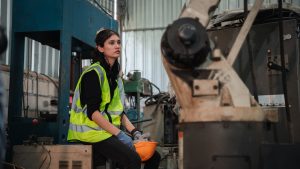Towards a More Inclusive Artificial Intelligence Economy
By: Polly Allen, Founder & CEO, AI Career Boost and Gary A. Officer, Founder & CEO, CWI Labs

Part 1 of this article discussed that the Artificial Intelligence (AI) evolution is upon us and how it is transforming the economy and workforce in ways we’ve never seen before. But as we march forward, we must not ignore the glaring fact that women and other minority groups are drastically underrepresented in the AI workforce, particularly in leadership positions. The risks of biased AI systems have rightfully been a hot topic in media, but we must also consider the potential for exacerbating existing hiring, promotion and compensation biases within the industry. The very groups under-represented in AI are the ones who stand to lose the most to job automation. These biases could disproportionately harm underrepresented groups and hinder the progress of AI. It’s time for action, not just words. In Part 2 we look at some of the workforce development efforts and organizations committed to leveling the playing field, pointing the way and providing hope for a more inclusive and equitable economy.
As we enter the AI era, a crucial question arises: what skills are necessary for this transition and where can we find them? Most recent studies focus on highly-educated, PhD-level researchers.
While these play a crucial role in advancing novel AI concepts and techniques, a larger and more diverse workforce with a wider range of skills is needed to implement these concepts into the technologies and systems driving our economic progress and shaping our AI-enabled society. In fact, a 2020 study from the Center for Security and Emerging Technology found that AI-adjacent roles NOT requiring a PhD are growing more quickly than Core AI and Data Science roles. We need to broaden our focus to support the successful implementation of AI in different sectors.
Academic & Technical Roles
Increasing diversity in technology-related academic programs, from undergraduate training through PhD levels, is an important goal undertaken by several groups that provide educational resources and training, promote research by women and minority groups, and provide pathways to academic opportunities – groups such as AI4ALL, Women in Machine Learning, and Black in AI.
Non-Technical Executive and Professional Roles

For older, established professionals, returning to college for a degree program is not always an option. To work directly with AI models requires an academic and technical background – but for business leadership functions like executive management, marketing, sales, product management and customer support, a higher-level understanding of AI – both its capabilities and inherent risks – is much easier to learn quickly. Many companies insist on technical credentials or experience for these functions in AI-related companies; unfortunately, this practice that is seldom recognized as a barrier to increased diversity. It is estimated that executives only need to know 30% of a handful of technical topics to be effective and ‘technically fluent’; similarly, in AI, familiarity with AI terms and data fluency can be enough to lead and work with technical teams effectively. Programs that focus on bridging AI fluency gaps for mid- and senior-career professionals are just beginning to emerge. As one example, AI Career Boost was founded with this exact segment in mind – experienced professionals looking to participate in the AI economy, without having to learn to program or return to school for an advanced degree. This AI-focused career accelerator for women offers bootcamp-style classes and workshops to help business leaders develop their digital AI mindset.
Skilled Trades & Manual Workforce
An important piece of the equitable AI workforce puzzle is ensuring that opportunities to develop digital literacy and skills are available to all. The workforce development community as best they can, have shifted their training approaches to incorporate, digital and technology-based training. The Center for Workforce Inclusion digital certification program is one new approach undertaken to prepare older workers for occupations which will provide them with the skills to work in a remote workplace. We have also observed the growing trend among many employers to remove college degrees as requirement for open jobs, and, instead, include industry recognized credentials, among the basic requirements for open positions. Government, too, have taken note of the need to build a more equitable workforce. States like Connecticut have allocated funding secured through the $1 trillion infrastructure bill to expand training programs for individuals lacking the technological skills needed to meet local labor demand.
Taken alone, each of the initiatives will struggle to have the impact they could when combined and scaled. There is hope – as long as such initiatives continue to gain focus and grow. Ultimately, we must strive for diversity and inclusion in the leadership, development, and implementation of AI from all segments of the economy to ensure societal equity and to unlock the full potential of this powerful technology.

